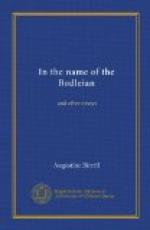was contemplated by the writer. The dodges and
devices of authors are well-nigh infinite and quite
beyond conjecture, and it is, of course, possible that
Lord Chesterfield kept copies of these letters, which
bear upon their faces evidence of care and elaboration.
It is not to be supposed for a moment that he ever
forgot he had written them. It is hard to believe
he never inquired after them and their whereabouts.
Great men have been known to write letters which,
though they bore other addresses, were really intended
for their biographers. It would not have been
surprising if Lord Chesterfield wrote these letters
intending some day to publish them, but not only is
there no warrant for such an opinion, but the opposite
is clearly established. It is, no doubt, odd that
the son should have carefully preserved more than
400 letters written to him during a period beginning
with his tenderest years and continuing whilst he
was travelling on the Continent. It seems almost
a miracle. What made the son treasure them so
carefully? Did he look forward to being his father’s
biographer? Hardly so at the age of ten, or even
twenty. Biographies were not then what they have
since become. No doubt in the middle of the eighteenth
century letters were more treasured than they are
to-day, and young Stanhope’s friends may also
have thought it wise to encourage him to preserve documentary
evidence of the great interest taken in him by his
father. None the less, I think the preservation
of this correspondence is in the circumstances a most
extraordinary though well-established fact.
The son died in 1768 of a dropsy at Avignon, and the
news was communicated to the Earl by his daughter-in-law,
Mrs. Eugenia Stanhope, of whose existence he was previously
unaware. Two grandsons accompanied her.
It was a shock; but ’les manieres nobles et aisees,
la tournure d’un homme de condition, le ton de
la bonne compagnie, les graces le je ne scais quoi
qui plait,’ came to Lord Chesterfield’s
assistance, and he received his son’s widow,
who was not a pleasing person, and her two boys with
kindness and good feeling, and provided for them quite
handsomely by his will. The Earl died in 1773,
in his seventy-ninth year, and thereupon Mrs. Stanhope,
who was in possession of all the original letters
addressed to her late husband, carried her wares to
market, and made a bargain with Mr. Dodsley for their
publication, she to receive L1,575. Mr. Dodsley
advertised the forthcoming work, and on that the Earl’s
executors, relying upon the well-known case of Pope
v. Curl, decided by Lord Hardwicke in 1741,
filed their bill against Mrs. Stanhope, seeking an
injunction to restrain publication. The widow
put in her sworn Answer, in which she averred that
she had, on more occasions than one, mentioned publication
to the Earl, and that he, though recovering from her
certain written characters of eminent contemporaries,
had seemed quite content to let her do what she liked




